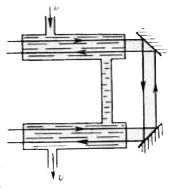In the Fizeau experiment two light beams travel head on, one along a stream of fluid, the other in the opposite direction (Fig. 6.6). If the length of each tube is 1, the veloc ity of the fluid v and its refractive index , what will be the difference between the travel times of the light beams?

The correct Answer is:Hint. Make use of the results of the previous problem.
The time the light takes to travel with the fluid stream is
t1=2lu=2l(1−v/cn)c/n−v
The time light travels against the stream is
t2=2lu.=2l(1+v/cn)c/n+v
The time difference is
τ=t1−t2=2l(c/n)2−v2[(1−vcn)(cn+v)−(1+vcn)(cn−v)]=4lv(1−1/n2)(c/n)2−v2
Noting that c/n<<v we obtain τ=4lvc2(n2−1).
Similar Questions
A beam of light travelling in water strikes a glass plate, which is also immersed in water. When the angle of incidence is 51∘, the reflected beam is found to be plane polarised . What is the refractive index of glass if the refractive index of water is 43? [tan51∘=1.235]
View SolutionA double convex thin lens made of the refractive index 1.6 has radii of curvature 15 cm each. What is the focal length (in cm) of this les when immersed in a fluid of refractive index 1.63?
View Solution
Knowledge Check
A beam of monochromatic blue light of wavelength 4200 Å in air , travels in water of refractive index 43 . What is the its wavelength in water ?
A4200 ÅB5600 ÅC3150 ÅD3850 ÅA light beam travelling along the x axis with planar wavefront is incident on a medium of thickness t. In the region, where light is falling the refractive index can be taken to be varying such that dndy>0. The light beam on the other side of the medium will emerge
Aparallel to the x-axisBbending downwardCbending upwardDsplit into two or more beamsA beam of light travelling in water strikes a glass plate, which is also immersed in water. When the angle of incidence is 51∘, the reflected beam is found to be plane polarised . What is the refractive index of glass if the refractive index of water is 43? [tan51∘=1.235]
A1.646B1.325C2.123D1.987
Unpolarised light falls on two polarizing sheets placed one on top of the other. What must be the angle between the characteristic directions of the sheets if the intensity of the final transmitted light is one-third the maximum intensity of the first transmitted beam?
View SolutionUnpolarised light falls on two polarizing sheets placed one on top of the other. What must be the angle between the characteristic directions of the sheets if the intensity of the final transmitted light is one-third the maximum intensity of the first transmitted beam?
View SolutionA beam of light travelling at a velocity of V m/s is incident at an angle 45∘ on a glass . Slab of refractive index 1.5. what is the velocity of the beam of light inside the slab ?
View SolutionA beam of light travelling at a velocity of v m/s is incident at
an angle 45∘ on a glass slab of refractive index 1.5. What is
the velocity of the beam of light inside the slab ?
View SolutionA ray of light incident normally on a glass slab of refractive index 3/2, travels a distance of 6 cm in glass in time t. What will be the distance travelled by the ray in the same time (t) if it travels in air ?
View Solution
